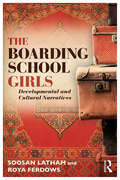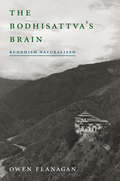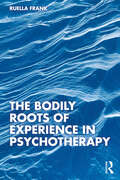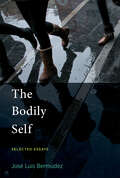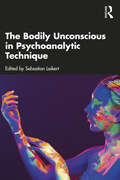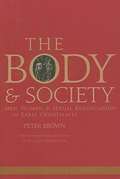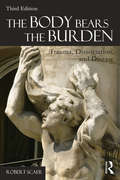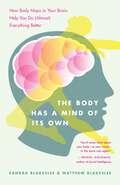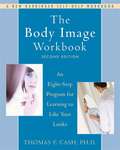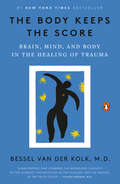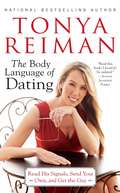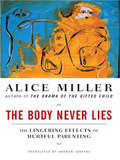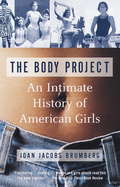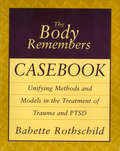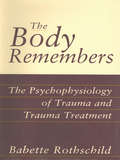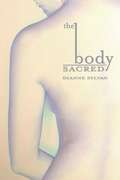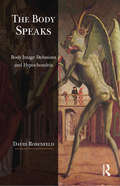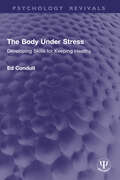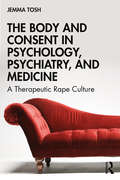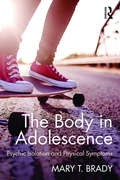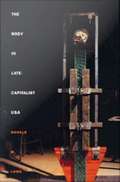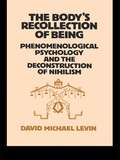- Table View
- List View
The Boarding School Girls: Developmental and Cultural Narratives
by Soosan Latham Roya FerdowsThey were children. Put on a train in a strange land, they waved goodbye to a parent as they headed to an educational institution that, unbeknownst to them, was to become their new home. Separated from their loving families, they strived to meet the expectations of the grownups and, in some cases, to rebel against them. Now, independent women, compassionate mothers, and astute professionals, they look back on their youth in the 1960’s and 1970’s to make sense of why they were sent away, and to give meaning to the sources that have sustained them over the years. Ex-boarders themselves, Latham and Ferdows provide vivid and emotionally embodied narratives of everyday lives of The Boarding School Girls. This unique collection of stories explores key issues of identity and lifespan development to seek understanding of the influence of national, religious and family culture on development within two conflicting sets of cultural values. Combining unique qualitative data with illuminating tales of resilience and accomplishment in what is likely to simultaneously inform and inspire readers with feelings of joy and sadness, love and hate, abandonment and hope, but mainly trust and forgiveness. The stories of eleven ‘little rich’ Persian girls are a nostalgic reminder of their past cross-cultural ordeals, a pragmatic perspective on psychological implications of boarding school education in England, and a celebration of the possibilities of the future. The Boarding School Girls is valuable reading for students in cultural, developmental and educational psychology and the humanities, as well as clinical psychologists and educators looking at the impact of boarding school on adolescent development.
The Bodhisattva's Brain: Buddhism Naturalized
by Owen FlanaganCan there be a Buddhism without karma, nirvana, and reincarnation that is compatible with the rest of knowledge?If we are material beings living in a material world—and all the scientific evidence suggests that we are—then we must find existential meaning, if there is such a thing, in this physical world. We must cast our lot with the natural rather than the supernatural. Many Westerners with spiritual (but not religious) inclinations are attracted to Buddhism—almost as a kind of moral-mental hygiene. But, as Owen Flanagan points out in The Bodhisattva's Brain, Buddhism is hardly naturalistic. In The Bodhisattva's Brain, Flanagan argues that it is possible to discover in Buddhism a rich, empirically responsible philosophy that could point us to one path of human flourishing. Some claim that neuroscience is in the process of validating Buddhism empirically, but Flanagan's naturalized Buddhism does not reduce itself to a brain scan showing happiness patterns. "Buddhism naturalized," as Flanagan constructs it, offers instead a fully naturalistic and comprehensive philosophy, compatible with the rest of knowledge—a way of conceiving of the human predicament, of thinking about meaning for finite material beings living in a material world.
The Bodily Roots of Experience in Psychotherapy
by Ruella FrankThis book explores the significance of movement processes as they shape one’s experience through life. It provides a comprehensive, practical understanding of how we lose the wonder and curiosity we move with as children, and how we can reclaim that. A new paradigm is presented in the making of experience through a radical and thorough investigation into the basics of animated life. The book utilizes a precise phenomenological language for those subverbal interactions that form the foundation of lived experience. The centrality of those interactions to the therapeutic encounter is set forth through richly detailed therapy vignettes. The building of experience is meticulously explored via the bridging of infant-parent dyads and the functional similarity of those dyads to the unfolding patient-therapist relationship. Readers learn to acknowledge routine inhibitions developed in early life, appreciate their former usefulness, and discover how to restore the lively flow of moving-feeling responses. This book is essential for all psychotherapists who wish to integrate the dynamics of movement into their work; educators who work with babies and young children; and all those wishing to understand better their psychophysical selves.
The Bodily Self: Selected Essays (The\mit Press Ser.)
by Jose Luis BermudezEssays on the role of the body in self-consciousness, showing that full-fledged, linguistic self-consciousness is built on a rich foundation of primitive, nonconceptual self-consciousness.These essays explore how the rich and sophisticated forms of self-consciousness with which we are most familiar—as philosophers, psychologists, and as ordinary, reflective individuals—depend on a complex underpinning that has been largely invisible to students of the self and self-consciousness. José Luis Bermúdez, extending the insights of his groundbreaking 1998 book, The Paradox of Self-Consciousness, argues that full-fledged, linguistic self-consciousness is built on a rich foundation of primitive, nonconceptual self-consciousness, and that these more primitive forms of self-consciousness persist in ways that frame self-conscious thought. They extend throughout the animal kingdom, and some are present in newborn human infants. Bermúdez makes the case that these primitive forms of self-awareness can indeed be described as forms of self-consciousness, arguing that they share certain structural and epistemological features with full-fledged, linguistic self-consciousness. He offers accounts of certain important classes of states of nonconceptual content, including the self-specifying dimension of visual perception and the content of bodily awareness, considering how they represent the self. And he explores the general role of nonconceptual self-consciousness in our cognitive and affective lives, examining in several essays the relation between nonconceptual awareness of our bodies and what has been called our “sense of ownership” for our own bodies.
The Bodily Unconscious in Psychoanalytic Technique
by Sebastian LeikertThe Bodily Unconscious in Psychoanalytic Technique explores how corporeality and body memory can be more strongly integrated into psychoanalytic work.This book brings together an international range of contributors to consider the bodily unconscious from different theoretical perspectives. Concepts from the work of Freud, Bion, Winnicott, Lacan, Laplanche, and Fonagy are developed with the aim of incorporating body memory into psychoanalytic technique. The contributors consider how severe and complex clinical states, dominated by bodily symptoms and disorganization, can be approached with methods that go beyond classical interpretation. The book includes ten case histories and discussion of key themes including transference and countertransference, feelings of corporeality and bodily sensations, and features clinical material throughout.The Bodily Unconscious in Psychoanalytic Technique will be essential reading for psychoanalysts and psychoanalytic psychotherapists in practice and training, particularly those interested in somatic approaches.
The Body And Society: Men, Women, and Sexual Renunciation in Early Christianity; Twentieth Anniversary Edition With A New Introduction
by Peter BrownFirst published in 1988, Peter Brown's The Body and Society was a groundbreaking study of the marriage and sexual practices of early Christians in the ancient Mediterranean and Near East. Brown focuses on the practice of permanent sexual renunciation-continence, celibacy, and lifelong virginity-in Christian circles from the first to the fifth centuries A. D. and traces early Christians' preoccupations with sexuality and the body in the work of the period's great writers. The Body and Society questions how theological views on sexuality and the human body both mirrored and shaped relationships between men and women, Roman aristocracy and slaves, and the married and the celibate. Brown discusses Tertullian, Valentinus, Clement of Alexandria, Origen, Constantine, the Desert Fathers, Jerome, Ambrose, and Augustine, among others, and considers asceticism and society in the Eastern Empire, martyrdom and prophecy, gnostic spiritual guidance, promiscuity among the men and women of the church, monks and marriage in Egypt, the ascetic life of women in fourth-century Jerusalem, and the body and society in the early Middle Ages. In his new introduction, Brown reflects on his work's reception in the scholarly community.
The Body Bears the Burden: Trauma, Dissociation, and Disease
by Robert ScaerWhen The Body Bears the Burden made its debut in 2001, it changed the way people thought about trauma, PTSD, and the treatment of chronic stress disorders. Now in its third edition, this revered text offers a fully updated and revised analysis of the relationship between mind, body, and the processing of trauma. Here, clinicians will find detailed, thorough explorations of some of neurobiology’s fundamental tenets, the connections between mind, brain, and body, and the many and varied ways that symptoms of traumatic stress become visible to those who know to look for them.
The Body Has a Mind of Its Own: How Body Maps in Your Brain Help You Do (Almost) Everything Better
by Sandra Blakeslee Matthew BlakesleeIn this compelling, cutting-edge book, two generations of science writers explore the exciting science of "body maps" in the brain-and how startling new discoveries about the mind-body connection can change and improve our lives. Why do you still feel fat after losing weight? What makes video games so addictive? How can "practicing" your favorite sport in your imagination improve your game? The answers can be found in body maps.Just as road maps represent interconnections across the landscape, your many body maps represent all aspects of your bodily self, inside and out. In concert, they create your physical and emotional awareness and your sense of being a whole, feeling self in a larger social world.Moreover, your body maps are profoundly elastic. Your self doesn't begin and end with your physical body but extends into the space around you. This space morphs every time you put on or take off clothes, ride a bike, or wield a tool. When you drive a car, your personal body space grows to envelop it. When you play a video game, your body maps automatically track and emulate the actions of your character onscreen. When you watch a scary movie, your body maps put dread in your stomach and send chills down your spine. If your body maps fall out of sync, you may have an out-of-body experience or see auras around other people.The Body Has a Mind of Its Own explains how you can tap into the power of body maps to do almost anything better-whether it is playing tennis, strumming a guitar, riding a horse, dancing a waltz, empathizing with a friend, raising children, or coping with stress. The story of body maps goes even further, providing a fresh look at the causes of anorexia, bulimia, obsessive plastic surgery, and the notorious golfer's curse "the yips." It lends insights into culture, language, music, parenting, emotions, chronic pain, and more. Filled with illustrations, wonderful anecdotes, and even parlor tricks that you can use to reconfigure your body sense, The Body Has a Mind of Its Own will change the way you think-about the way you think."The Blakeslees have taken the latest and most exciting finds from brain research and have made them accessible. This is how science writing should always be."-Michael S. Gazzaniga, Ph.D., author of The Ethical Brain"Through a stream of fascinating and entertaining examples, Sandra Blakeslee and Matthew Blakeslee illustrate how our perception of ourselves, and indeed the world, is not fixed but is surprisingly fluid and easily modified. They have created the best book ever written about how our sense of 'self' emerges from the motley collection of neurons we call the brain."-Jeff Hawkins, co-author of On Intelligence "The Blakeslees have taken the latest and most exciting finds from brain research and have made them accessible. This is how science writing should always be."-Michael S. Gazzaniga, Ph.D., author of The Ethical Brain"A marvelous book. In the last ten years there has been a paradigm shift in understanding the brain and how its various specialized regions respond to environmental challenges. In addition to providing a brilliant overview of recent revolutionary discoveries on body image and brain plasticity, the book is sprinkled with numerous insights."-V. S. Ramachandran, M.D., director, Center for Brain and Cognition, University of California, San DiegoFrom the Hardcover edition.
The Body Image Workbook: An Eight-step Program for Learning to Like your Looks (Second Edition)
by Thomas F. CashThis revised edition of The Body Image Workbook notably integrates the new and popular disciplines of mindfulness, acceptance, and expressive writing with well established, effective cognitive and behavioral procedures for body image change.The book offers a comprehensive program to help you stop focusing on your perceived imperfections and start feeling more confident about the way you look. It incorporates new scientific knowledge about body image and about contemporary cognitive behavioral approaches to human change. It is for people who are dissatisfied with their looks and want to do something about it. This book is for women and men, teenagers and adults. It is for average-looking folks and for those who "look different"--whether fat or thin, tall or short, disfigured or a "perfect 10."
The Body Keeps the Score: Brain, Mind, and Body in the Healing of Trauma
by Bessel van der KolkTrauma is a fact of life. Veterans and their families deal with the painful aftermath of combat; one in five Americans has been molested; one in four grew up with alcoholics; one in three couples have engaged in physical violence. Dr. Bessel van der Kolk, one of the world's foremost experts on trauma, has spent over three decades working with survivors. <p><p> In The Body Keeps the Score, he uses recent scientific advances to show how trauma literally reshapes both body and brain, compromising sufferers' capacities for pleasure, engagement, self-control, and trust. He explores innovative treatments--from neurofeedback and meditation to sports, drama, and yoga--that offer new paths to recovery by activating the brain's natural neuroplasticity. <p> Based on Dr. van der Kolk's own research and that of other leading specialists, The Body Keeps the Score exposes the tremendous power of our relationships both to hurt and to heal--and offers new hope for reclaiming lives. <p><b>A New York Times Bestseller</b>
The Body Language of Dating: Read His Signals, Send Your Own, and Get the Guy
by Tonya ReimanPrimal instinct meets the power of choice in this go-to guide to getting the guy. The last time you locked eyes with a gorgeous, manly specimen across the room or took a detour past the object of your affection, fluffing your locks on your way to the powder room, you probably didn't think you were performing an ancient mating dance. Whether the fashion of the day is miniskirts or mammoth hides, the knowing glances, chest puffing, hair tossing, and backside brandishing are all part of a complicated ritual choreographed over epochs and designed for your very survival. Thankfully, evolution has taken care of the hard part, leaving today's woman with the sometimes daunting task of deciphering the intriguing, often infuriating signals of modern man. In this smart, funny, and invaluable book, nationally renowned body language expert Tonya Reiman decodes the complicated dating game. While some of us seem to have been born with a razor-sharp "sexual instinct," the rest of us could use a little practice. Luckily, the formula for dating success is easy to learn. Within these pages, you'll discover how to display the body language necessary for making solid connections with potential mates, uncover the mysteries of man himself, and find handy new tricks for your attraction arsenal. Not only that, The Body Language of Dating will teach you how to: Whether you feel like you couldn't attract a fireman with your head ablaze or just want to give your seasoned connection-rejection ratio a boost, Tonya Reiman will help you shave time, effort, and heartbreak from your mating quest. She didn't make the rules, but she sure can teach you how to use them. * Read a guy's facial expressions, gestures, and posture for clues to his state of mind. * Tell long-term mates from short-term dates. (Hint: You can often tell just by looking at him!) * Send silent messages that tug on your hottie's heartstrings. * Save yourself from losers like Not-Interested Nate and Stalker Steve and get straight to Mr. Right (or Mr. Right Now). * Wield the science of scent in any social situation. Whether you feel like you couldn't attract a fireman with your head ablaze or just want to give your seasoned connection-rejection ratio a boost, Tonya Reiman will help you shave time, effort, and heartbreak from your mating quest. She didn't make the rules, but she sure can teach you how to use them.
The Body Never Lies: The Lingering Effects of Cruel Parenting
by Alice Miller Andrew JenkinsAn examination of childhood trauma and its surreptitious, debilitating effects by one of the world's leading psychoanalysts. Never before has world-renowned psychoanalyst Alice Miller examined so persuasively the long-range consequences of childhood abuse on the body. Using the experiences of her patients along with the biographical stories of literary giants such as Virginia Woolf, Franz Kafka, and Marcel Proust, Miller shows how a child's humiliation, impotence, and bottled rage will manifest itself as adult illness--be it cancer, stroke, or other debilitating diseases. Never one to shy away from controversy, Miller urges society as a whole to jettison its belief in the Fourth Commandment and not to extend forgiveness to parents whose tyrannical childrearing methods have resulted in unhappy, and often ruined, adult lives. In this empowering work, writes Rutgers professor Philip Greven, "readers will learn how to confront the overt and covert traumas of their own childhoods with the enlightened guidance of Alice Miller."
The Body Project: An Intimate History of American Girls
by Joan Jacobs Brumberg"Timely and sympathetic . . . a work of impassioned advocacy. " --People. A hundred years ago, women were lacing themselves into corsets and teaching their daughters to do the same. The ideal of the day, however, was inner beauty: a focus on good deeds and a pure heart. Today American women have more social choices and personal freedom than ever before. But fifty-three percent of our girls are dissatisfied with their bodies by the age of thirteen, and many begin a pattern of weight obsession and dieting as early as eight or nine. Why? In The Body Project, historian Joan Jacobs Brumberg answers this question, drawing on diary excerpts and media images from 1830 to the present. Tracing girls' attitudes toward topics ranging from breast size and menstruation to hair, clothing, and cosmetics, she exposes the shift from the Victorian concern with inner beauty to our modern focus on outward appearance--in particular, the desire to be model-thin and sexy. Compassionate, insightful, and gracefully written,The Body Project explores the gains and losses adolescent girls have inherited since they shed the corset and the ideal of virginity for a new world of sexual freedom and consumerism--a world in which the body is their primary project. "Joan Brumberg's book offers us an insightful and entertaining history behind the destructive mantra of the '90s--'I hate my body!'" --Katie Couric
The Body Remembers Casebook: Unifying Methods and Models in the Treatment of Trauma and PTSD
by Babette RothschildThis is the first book of its kind to advocate utilizing and combining an assortment of trauma treatment models. Based on ideas put forward in the bestselling The Body Remembers, Babette Rothschild emphasizes the importance of tailoring every trauma therapy to the particular needs of each individual client. A breath of fresh air in the competitive 'mine is best' atmosphere currently so divisive in the field of trauma therapy, each varied and complex case (presented in a variety of writing styles: case reports, session-by-session narratives, single session transcripts) is approached with a combination of methods ranging from traditional psychodynamic and cognitive approaches and applications of attachment theory to innovative trauma methods including EMDR and Levine's SIBAM model. Read on its own on or in conjunction with The Body Remembers, clinicians from all disciplines will discover new strategies and gain insight into how to combine various treatment models for increased success with traumatized clients.
The Body Remembers Volume 2: Revolutionizing Trauma Treatment
by Babette RothschildChallenging the notion that clients with PTSD must revisit, review, and process their memories to recover from trauma. The Body Remembers, Volume 2: Revolutionizing Trauma Treatment continues the discussion begun more than fifteen years ago with the publication of the best-selling and beloved The Body Remembers: The Psychophysiology of Trauma and Trauma Treatment. This new book is grounded in the belief that the most important goal for any trauma treatment is to improve the quality of life of the client. Therefore, the first prerequisite is that the client be reliably stable and feel safe in his or her daily life as well as the therapy situation. To accomplish this, Babette Rothschild empowers both therapists and clients by expanding trauma treatment options. For clients who prefer not to review memories, or are unable to do so safely, new and expanded strategies and principles for trauma recovery are presented. And for those who wish to avail themselves of more typical trauma memory work, tools to make trauma memory resolution even safer are included. Being able to monitor and modulate a trauma client’s dysregulated nervous system is one of the practitioner’s best lines of defense against traumatic hyperarousal going amok—risking such consequences as dissociation and decompensation. Rothschild clarifies and simplifies autonomic nervous system (ANS) understanding and observation with her creation of an original full color table that distinguishes six levels of arousal. Included in this table (and the discussion that accompanies it) is a new and essential distinction between trauma-induced hypoarousal and the low arousal that is caused by lethargy or depression. The full color ANS table is also available from W.W. Norton as a laminated desk reference and a wall poster suitable for framing so this valuable therapeutic tool will always be at hand. Principles and theory come alive through multiple demonstration therapy transcripts that illustrate: Stabilizing a new client who consistently dissociates due to persistent trauma flashbacks Clarifying and keeping therapeutic contracts Identifying and implementing hidden somatic resources for stabilization Easing transition from Phase 1 to Phase 2 trauma treatment via trauma memory outlining Utilizing good memories and somatic markers as antidotes to traumatic memory Combining an authoritative yet personal voice, Rothschild gives clinicians the space to recognize where they may have made mistakes—by sharing her own!—as well as a road map toward more effective practice in the future. This book is absolutely essential reading for anyone working with those who have experienced trauma.
The Body Remembers: The Psychophysiology of Trauma and Trauma Treatment
by Babette RothschildFor both clinicians and their clients there is tremendous value in understanding the psychophysiology of trauma and knowing what to do about its manifestations. This book illuminates that physiology, shining a bright light on the impact of trauma on the body and the phenomenon of somatic memory. It is now thought that people who have been traumatized hold an implicit memory of traumatic events in their brains and bodies. That memory is often expressed in the symptomatology of posttraumatic stress disorder-nightmares, flashbacks, startle responses, and dissociative behaviors. In essence, the body of the traumatized individual refuses to be ignored. While reducing the chasm between scientific theory and clinical practice and bridging the gap between talk therapy and body therapy, Rothschild presents principles and non-touch techniques for giving the body its due. With an eye to its relevance for clinicians, she consolidates current knowledge about the psychobiology of the stress response both in normally challenging situations and during extreme and prolonged trauma. This gives clinicians from all disciplines a foundation for speculating about the origins of their clients' symptoms and incorporating regard for the body into their practice. The somatic techniques are chosen with an eye to making trauma therapy safer while increasing mind-body integration. Packed with engaging case studies, The Body Remembers integrates body and mind in the treatment of posttraumatic stress disorder. It will appeal to clinicians, researchers, students, and general readers.
The Body Remembers: The Psychophysiology of Trauma and Trauma Treatment
by Babette RothschildFor both clinicians and their clients there is tremendous value in understanding the psychophysiology of trauma and knowing what to do about its manifestations.<P><P> This book illuminates that physiology, shining a bright light on the impact of trauma on the body and the phenomenon of somatic memory.<P> It is now thought that people who have been traumatized hold an implicit memory of traumatic events in their brains and bodies. That memory is often expressed in the symptomatology of posttraumatic stress disorder-nightmares, flashbacks, startle responses, and dissociative behaviors. In essence, the body of the traumatized individual refuses to be ignored.<P> While reducing the chasm between scientific theory and clinical practice and bridging the gap between talk therapy and body therapy, Rothschild presents principles and non-touch techniques for giving the body its due. With an eye to its relevance for clinicians, she consolidates current knowledge about the psychobiology of the stress response both in normally challenging situations and during extreme and prolonged trauma. This gives clinicians from all disciplines a foundation for speculating about the origins of their clients' symptoms and incorporating regard for the body into their practice. The somatic techniques are chosen with an eye to making trauma therapy safer while increasing mind-body integration.<P> Packed with engaging case studies, The Body Remembers integrates body and mind in the treatment of posttraumatic stress disorder. It will appeal to clinicians, researchers, students, and general readers.
The Body Sacred
by Dianne SylvanEach chapter of The Body Sacred includes spells, rituals, myths, and meditations designed to help you build a positive self-image and rejoice in the sacred aspects of the female body you were blessed with. Explore six divine female archetypes, and discover how these powerful themes can help you love and celebrate your body as a gorgeous, living temple of the Goddess.
The Body Speaks: Body Image Delusions and Hypochondria
by David RosenfeldThis book explores the author's pioneering work with severely disturbed patients, to show what it means to work and think as a psychoanalyst about transference and the internal world of a psychotic patient, with all the difficulties involved in continuing to treat and engage with even severely ill patients. As the author suggests, to be a psychoanalyst is to think about transference, the patient's internal world and projective identifications onto the therapist and onto persons in the external world. In particular, the author examines patients who express their mental state through fantasies about their body image. For example, the fantasy of an emptying of the self is discussed through the case of the patient Pierre, who asserts that he has no more blood or liquids in his body. Similarly, the fantasies of a young man who says that bats are flying out of his cheeks incarnate the anxiety of his first months of life expressed through his body. Indeed, the author's particular focus is on the importance of the first months and years in the life of these patients.
The Body Under Stress: Developing Skills for Keeping Healthy (Psychology Revivals)
by Ed ConduitOriginally published in 1995, The Body Under Stress, reissued here with a new preface, seeks to define positive health, the skills needed to acquire it, and how to pass them on to others as part of education and counselling on health issues.Most people now view health as “fitness” – a repertoire of skills or health behaviours, necessary to overcome: excessive workload; bereavement; reliance on alcohol, tobacco or other drugs; over-use of back or neck. While many of these behaviours are acquired informally, some need to be taught by health professionals. This need was being recognized at a time when health services were increasing their interest in the maintenance of health, in addition to the treatment of illness.A scientific approach to positive health is relevant equally to medical and complementary health practices. The second half of this book examines the evidence that health behaviours can prevent illnesses such as: heart disease; ulcers; back injuries.A comprehensive review of the research and development at the time, this book will still be of interest to many health professionals for whom patient education and counselling is a major part of their role. This includes many nurses, remedial therapists, clinical and health psychologists, and complementary practitioners. Such readers, and clients wishing to make better use of consultations with their doctors, will find this book an indispensable storehouse of information.
The Body and Consent in Psychology, Psychiatry, and Medicine: A Therapeutic Rape Culture
by Jemma ToshThis groundbreaking text interrogates the constructed boundary between therapy and violence, by examining therapeutic practice and discourse through the lens of a psychologist and a survivor of sexual abuse. It asks, what happens when those we approach for help cause further harm? Can we identify coercive practices and stop sexual abuse in psychology, psychiatry, and medicine? Tosh explores these questions and more to illustrate that many of the therapies considered fundamental to clinical practice are deeply problematic when issues of consent and sexual abuse are considered. The book examines a range of situations where medical power and authority produces a context where the refusals and non-consent of oppressed groups are denied, dismissed, or ignored, arguing that key concepts and discourses have resulted in the production and standardisation of a therapeutic rape culture in the helping professions. Tosh uses critical intersectionality theory and discourse analysis to expertly highlight the complex interrelationships between race, class, gender, sexuality, and disability in our understanding of abuse and how we define survivors. Drawing on a wide range of comprehensive examples, including experiences and perspectives from cisgender and transgender men and women, as well as nonbinary and intersex people, this is essential reading for students and researchers of critical and queer psychology, gender studies, as well as mental health practitioners and social workers.
The Body in Adolescence: Psychic Isolation and Physical Symptoms
by Mary BradyThe Body in Adolescence: Psychic Isolation and Physical Symptoms examines the affective experience of psychic isolation as an important and painful element of adolescent development. Mary Brady begins by discussing how psychic isolation, combined with the intensity of adolescent processes, can leave adolescents unable to articulate their experience. She then shows how the therapist can understand and help adolescents whose difficulty with articulation and symbolization can leave them vulnerable to breakdown into physical bodily symptoms. This book introduces fresh ideas about adolescent development in the first chapter. Subsequent chapters include clinical essays involving adolescent patients presenting with bodily expressions such as anorexia, bulimia, cutting, substance abuse, and suicide attempts. Attention is also paid to adolescents' use of social media in relation to these bodily symptoms - such as their use of on-line 'pro-ana' or cutting sites. Clinicians can feel challenged or even stymied when presented with their adolescent patient's fresh cut or recent episode of binge drinking. Brady uses Bion's conceptualization of containment and the balance of psychotic versus integrative parts of the personality to examine the emergence of concrete bodily symptoms in adolescence. Throughout, Mary Brady offers ways of understanding and empathically engaging with adolescents. This book is essential reading for psychoanalysts and psychotherapists who treat adolescents and other patients with physical symptoms, as well as other readers with an interest in the psychoanalytic understanding of these issues.
The Body in Late-Capitalist USA
by Donald M. LoweIn The Body in Late-Capitalist USA, Donald M. Lowe explores the varied social practices that code and construct the body. Arguing that our bodily lives are shaped by a complex of daily and ongoing practices--how we work, what we buy and consume--Lowe contends that as a result of the commodification of these and other social practices in the late-twentieth century, what we often understand to be the needs of the body are in fact means for capital accumulation. Moving beyond studies of representations and images of the body, Lowe focuses on the intersection of body practices, language, and the Social to describe concretely the reality of a lived body. His strongly synthetic work brings together Marxist critique, semiotics, Foucaultian discourse analysis, and systems and communications theory to examine those practices that construct the body under late capitalism: habits of work and consumption, the ways we give birth and raise children, socialization, mental and physical healing, reconstructions and contestations of sexuality and gender. Lowe draws upon a wide range of sources, including government and labor studies and statistics, diagnostic and statistical manuals on mental illness, computer manuals, self-help books, and guides to work-related stress disorders, to illustrate the transformation of the body into a nexus of exchange value in postmodern society.
The Body of the Organisation and its Health
by Richard Morgan-JonesUsing the frameworks of psychoanalysis, group relations, systemic organisational observation, consulting and research, this book explores the relationship between the health of the work force and the health of organisations. It seeks to do this through an exploration of experience that has three dimensions linked in a single matrix: The bodily, the emotional and the social. This exploration is inspired by Bion's original idea of the protomental matrix from which the group dynamics of basic assumption mentality are derived, leading to his initial ideas about group diseases and their cures.
The Body's Recollection of Being: Phenomenological Psychology and the Deconstruction of Nihilism
by David Michael LevinThis is a unique study, contuining the work of Merleau-Ponty and Heidegger, and using the techniques of phenomenology against the prevailing nihilism of our culture. It expands our understanding of the human potential for spiritual self-realization by interpreting it as the developing of a bodily-felt awareness informing our gestures and movements. The author argues that a psychological focus on our experience of well-being and pathology as embodied beings contributes significantly to a historically relevant critique of ideology. It also provides an essential touchstone in experience for a fruitful individual and collective response to the danger of nihilism. Dr Levin draws on Merleau-Ponty's phenomenology to clarify Heidegger's analytic of human beings through an interpretation that focuses on our experience of being embodied. He reconstructs in modern terms the wisdom implicit in western and semitic forms of religion and philosophy, considering the work of Freud, Jung, Focault and Neitzsche, as well as that of American educational philosophers, including Dewey. In particular, he draws on the psychology of Freud and Jung to clarify our historical experience of gesture and movement and to bring to light its potential in the fulfilment of Selfhood. Throughout the book, the pathologies of the ego and its journey into Selfhood are considered in relation to the conditons of technology and the powers of nihilism.
